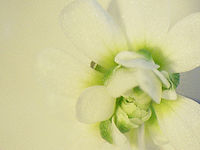
Double-flowered
Encyclopedia

Flower
A flower, sometimes known as a bloom or blossom, is the reproductive structure found in flowering plants . The biological function of a flower is to effect reproduction, usually by providing a mechanism for the union of sperm with eggs...
s with extra petal
Petal
Petals are modified leaves that surround the reproductive parts of flowers. They often are brightly colored or unusually shaped to attract pollinators. Together, all of the petals of a flower are called a corolla. Petals are usually accompanied by another set of special leaves called sepals lying...
s, often containing flowers within flowers. The double-flowered trait is often noted alongside the scientific name with the abbreviation fl. pl. (flore pleno, an ablative
Ablative case
In linguistics, ablative case is a name given to cases in various languages whose common characteristic is that they mark motion away from something, though the details in each language may differ...
form meaning "with full flower"). The first abnormality to be documented in flowers, double flowers are popular varieties of many commercial flower types, including rose
Rose
A rose is a woody perennial of the genus Rosa, within the family Rosaceae. There are over 100 species. They form a group of erect shrubs, and climbing or trailing plants, with stems that are often armed with sharp prickles. Flowers are large and showy, in colours ranging from white through yellows...
s, camellia
Camellia
Camellia, the camellias, is a genus of flowering plants in the family Theaceae. They are found in eastern and southern Asia, from the Himalaya east to Korea and Indonesia. There are 100–250 described species, with some controversy over the exact number...
s and carnations. Where seed is available few double varieties "come true" from seed; many double flower varieties have no reproductive organs — as a result, they are sexually sterile
Sterility (physiology)
Sterility is the physiological inability to effect sexual reproduction in a living thing, members of whose kind have been produced sexually. The term may be used in reference to* types of organism, such as the mule, a sterile hybrid;...
and must be propagated through cuttings. Environmental agencies ask gardeners not to plant double-flowered species as they have little or no wildlife value as access to the nectaries is typically blocked by the mutation.
History
Double flowers are the earliest documented form of floral abnormality, first recognized more than two thousand years ago. TheophrastusTheophrastus
Theophrastus , a Greek native of Eresos in Lesbos, was the successor to Aristotle in the Peripatetic school. He came to Athens at a young age, and initially studied in Plato's school. After Plato's death he attached himself to Aristotle. Aristotle bequeathed to Theophrastus his writings, and...
mentioned double roses in his Enquiry into Plants, written before 286BC. Pliny
Pliny the Elder
Gaius Plinius Secundus , better known as Pliny the Elder, was a Roman author, naturalist, and natural philosopher, as well as naval and army commander of the early Roman Empire, and personal friend of the emperor Vespasian...
also described double roses in 1st century BC. In China, double peonies were known and selected by around 750AD, and around 1000AD double varieties of roses were cultivated to form the China rose
Rosa chinensis
Rosa chinensis, known commonly as the China Rose, is a member of the genus Rosa native to Southwest China in Guizhou, Hubei, and Sichuan Provinces....
(one of the ancestors of modern Hybrid Tea
Hybrid Tea
Hybrid Tea is a cultivar group of roses, created by cross-breeding two different types of roses, initially by hybridising Hybrid Perpetuals with Tea roses...
roses). Today, most cultivated rose varieties bear this double-flower trait.

Rembert Dodoens
Rembert Dodoens was a Flemish physician and botanist, also known under his Latinized name Rembertus Dodonaeus.-Biography:...
published a description of double flowers in 1568, and John Gerard
John Gerard
John Gerard aka John Gerarde was an English herbalist notable for his herbal garden and botany writing. In 1597 he published a large and heavily illustrated "Herball, or Generall Historie of Plantes", which went on to be the most widely circulated botany book in English in the 17th century...
created illustrations of many double flowers beside their wild-type counterparts in 1597. A double-flowered variety of Marsh Marigold was discovered and cultivated in Austria in the late 16th century, becoming a valued garden plant.
The first documented double-flowered mutant of Arabidopsis
Arabidopsis thaliana
Arabidopsis thaliana is a small flowering plant native to Europe, Asia, and northwestern Africa. A spring annual with a relatively short life cycle, arabidopsis is popular as a model organism in plant biology and genetics...
, a model organism for plant development and genetics, was recorded in 1873. The mutated gene likely responsible for the phenotype, AGAMOUS, was cloned and characterized in 1990 in Elliot Meyerowitz
Elliot Meyerowitz
Elliot Meyerowitz is an American biologist.He is George W. Beadle Professor of Biology, Division of Biology at the California Institute of Technology, he served as Chair of the Biology Division from 2000 to 2010....
's lab as part of his study of molecular mechanisms of pattern formation in flowers.
Genetics of double-flower mutations

Stamen
The stamen is the pollen producing reproductive organ of a flower...
s in a flower are replaced by petal
Petal
Petals are modified leaves that surround the reproductive parts of flowers. They often are brightly colored or unusually shaped to attract pollinators. Together, all of the petals of a flower are called a corolla. Petals are usually accompanied by another set of special leaves called sepals lying...
s. These types of mutations, where one organ in a developing organism is replaced with another, are known as homeotic mutations. They are usually recessive
Recessive
In genetics, the term "recessive gene" refers to an allele that causes a phenotype that is only seen in a homozygous genotype and never in a heterozygous genotype. Every person has two copies of every gene on autosomal chromosomes, one from mother and one from father...
, although the double flower mutation in carnation
Carnation
Dianthus caryophyllus is a species of Dianthus. It is probably native to the Mediterranean region but its exact range is unknown due to extensive cultivation for the last 2,000 years. It is the wild ancestor of the garden carnation.It is a herbaceous perennial plant growing to 80 cm tall...
s exhibits incomplete dominance.
In Arabidopsis
Arabidopsis thaliana
Arabidopsis thaliana is a small flowering plant native to Europe, Asia, and northwestern Africa. A spring annual with a relatively short life cycle, arabidopsis is popular as a model organism in plant biology and genetics...
, which has been used as a model for understanding flower development, the double-flower gene AGAMOUS encodes a protein responsible for tissue specification of stamen and carpel flower segments. When both copies of the gene are deleted or otherwise damaged, developing flowers lack the signals to form stamen and carpel segments. Regions which would have formed stamens instead default to petals and the carpel region develops into a new flower, resulting in a recursive sepal
Sepal
A sepal is a part of the flower of angiosperms . Collectively the sepals form the calyx, which is the outermost whorl of parts that form a flower. Usually green, sepals have the typical function of protecting the petals when the flower is in bud...
-petal-petal pattern. Because no stamens and carpels form, the plants have no reproductive organs and are sexually sterile.
Mutations affecting flower morphology in Arabidopsis can be described by the ABC model of flower development. In this model, genes involved in flower formation belong to one of three classes of genes: A class genes which affect sepal and petal formation, B class genes which affect petal and stamen formation, and C class genes which affect stamen and carpel formation. These genes are expressed in certain regions of the developing flower and are responsible for development of organs in those regions. Agamous is a C class gene, a transcription factor
Transcription factor
In molecular biology and genetics, a transcription factor is a protein that binds to specific DNA sequences, thereby controlling the flow of genetic information from DNA to mRNA...
responsible for activating genes involved in stamen and carpel development.

